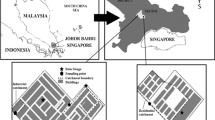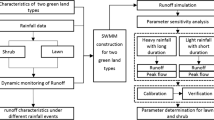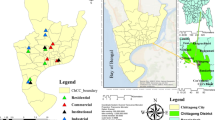Abstract
While point source pollutions have gradually been controlled in recent years, the non-point source pollution problem has become increasingly prominent. The receiving waters are frequently polluted by the initial stormwater from the separate stormwater system and the wastewater from sewage pipes through stormwater pipes. Consequently, calculating the intercepted runoff depth has become a problem that must be resolved immediately for initial stormwater pollution management. The accurate calculation of intercepted runoff depth provides a solid foundation for selecting the appropriate size of intercepting facilities in drainage and interception projects. This study establishes a separate stormwater system for the Yishan Building watershed of Fuzhou City using the InfoWorks Integrated Catchment Management (InfoWorks ICM), which can predict the stormwater flow velocity and the flow of discharge outlet after each rainfall. The intercepted runoff depth is calculated from the stormwater quality and environmental capacity of the receiving waters. The average intercepted runoff depth from six rainfall events is calculated as 4.1 mm based on stormwater quality. The average intercepted runoff depth from six rainfall events is calculated as 4.4 mm based on the environmental capacity of the receiving waters. The intercepted runoff depth differs when calculated from various aspects. The selection of the intercepted runoff depth depends on the goal of water quality control, the self-purification capacity of the water bodies, and other factors of the region.


Similar content being viewed by others
References
Athanasiadis K, Horn H, Helmreich B (2010) A field study on the first flush effect of copper roof runoff. Corros Sci 52(1):21–29
Chang CH, Wen CG, Lee CS (2008) Use of intercepted runoff depth for stormwater runoff management in industrial parks in Taiwan. Water Resour Manag 22(11):1609–1623
Choi SC, Jung DI, Won CH, Rim JM (2006) Calculation of intercepted volume of sewer overflows: a model for control of nonpoint pollution sources in urban areas. J Ocean Univ China 5(4):317–321
Environmental Resource Management Division (1990) The first flush of runoff and its effect on control structure design. Department of Environment and Conservation Services, Austin, TX. Available at: http://www.cityofaustin.org/watershed/firstflush.pdf
Frehmann T, Nafo I, Niemann A, Geiger WF (2002) Storm water management in an urban catchment: effects of sources control and real-time management of sewer system on receiving water quality. Wat Sci Technol 46(6–7):19–26
Grisham DM (1995) Designing for the “first flush”. Civil Eng 65(11):67–69
Jiang Ye (2006) Analysis and study on the environment and economy benefit of intercepting ratio in intercepted combined trunk sewer. Master of Engineering in Municipal Engineering in the Graduate School of Hunan University
Jung JW, Park HN, Choi DH, Baek SS, Yoon KS, Yoon KS, Baek WJ, Beam JA, Lim BJ (2013) Analysis of first flush of recreation park and removal rate according to rainfall-runoff storage depth. J Koream Soc Water Environ 29(5):648–655
Kim LH, Kayhanian M, Lau SL, Stenstrom MK (2005) A new modeling approach for estimating first flush metal mass loading. Water Sci Technol 51(3-4):159–167
Lee H, Lau SL, Kayhanian M, Stenstrom MK (2004) Seasonal first flush phenomenon of urban stormwater discharges. Water Res 38:4153–4163
Metadier M, Bertrand-Krajewski JL (2012) The use of long-term on-line turbidity measurements for the calculation of urban stormwater pollutant concentrations, loads, pollutographs and intra-event fluxes. Water Res 46(20):6836–6856
Peng H, Liu Y, Wang H et al (2016) Urban stormwater forecasting model and drainage optimization based on water environmental capacity. Environ Earth Sci 75:1094
Schueler TR (2000) First flush of stormwater pollutants investigated in Texas. In: Schueler TR, Holland HK (eds) Practice of watershed protection. Center for Watershed Protection, Ellicott City
State Environmental Protection Administration (SEPA) (2002) Standard of surface water environment quality (GB3838–2002). pp 3–6
Temprano J, Arango O, Cagiao J, Suarez J, Tejero I (2006) Stormwater quality calibration by SWMM: a case study in northern Spain. Water SA 32(1):55–63
Verdaguer M, Clara N, Gutierrez O, Poch M (2014) Application of ant-colony-optimization algorithm for improved management of first flush effects in urban wastewater systems. Sci Total Environ 485-486:143–152
Zhang Q, Liu Y (2014) Determination of interception capacity of initial rainwater in Dianchi Lake Basin. China Water Wastewater 30(13):115–118
Acknowledgements
The authors thank Fuzhou Planning Design Research Institute for providing the rainfall data.
Author information
Authors and Affiliations
Corresponding author
Additional information
Responsible editor: Marcus Schulz
Rights and permissions
About this article
Cite this article
Peng, HQ., Liu, Y., Gao, XL. et al. Calculation of intercepted runoff depth based on stormwater quality and environmental capacity of receiving waters for initial stormwater pollution management. Environ Sci Pollut Res 24, 24681–24689 (2017). https://doi.org/10.1007/s11356-017-9800-0
Received:
Accepted:
Published:
Issue Date:
DOI: https://doi.org/10.1007/s11356-017-9800-0




